Using Landsat 8/9 Thermal Bands to Detect Potential Submarine Groundwater Discharge (SGD) Sites in the Mediterranean in North West-Central Morocco
Abstract
1. Introduction
2. Materials and Methods
2.1. Study Area
2.2. Data Acquisition and Refinement
2.3. Standardized Thermal Anomaly
2.4. Potential Locations per Date
2.5. Potential Locations from Multiple Images (Fuzzy Function)
3. Results
3.1. Potential Locations per Day
3.2. Potential Locations from Multiple Images (Fuzzy Function)
- Dark blue (1.0)—highest probability of SGD;
- Light blue (0.75)—moderate probability;
- Beige (0.50)—low probability;
- Light brown (0.25)—extremely low probability;
- Red (0.0)—no SGD probability.
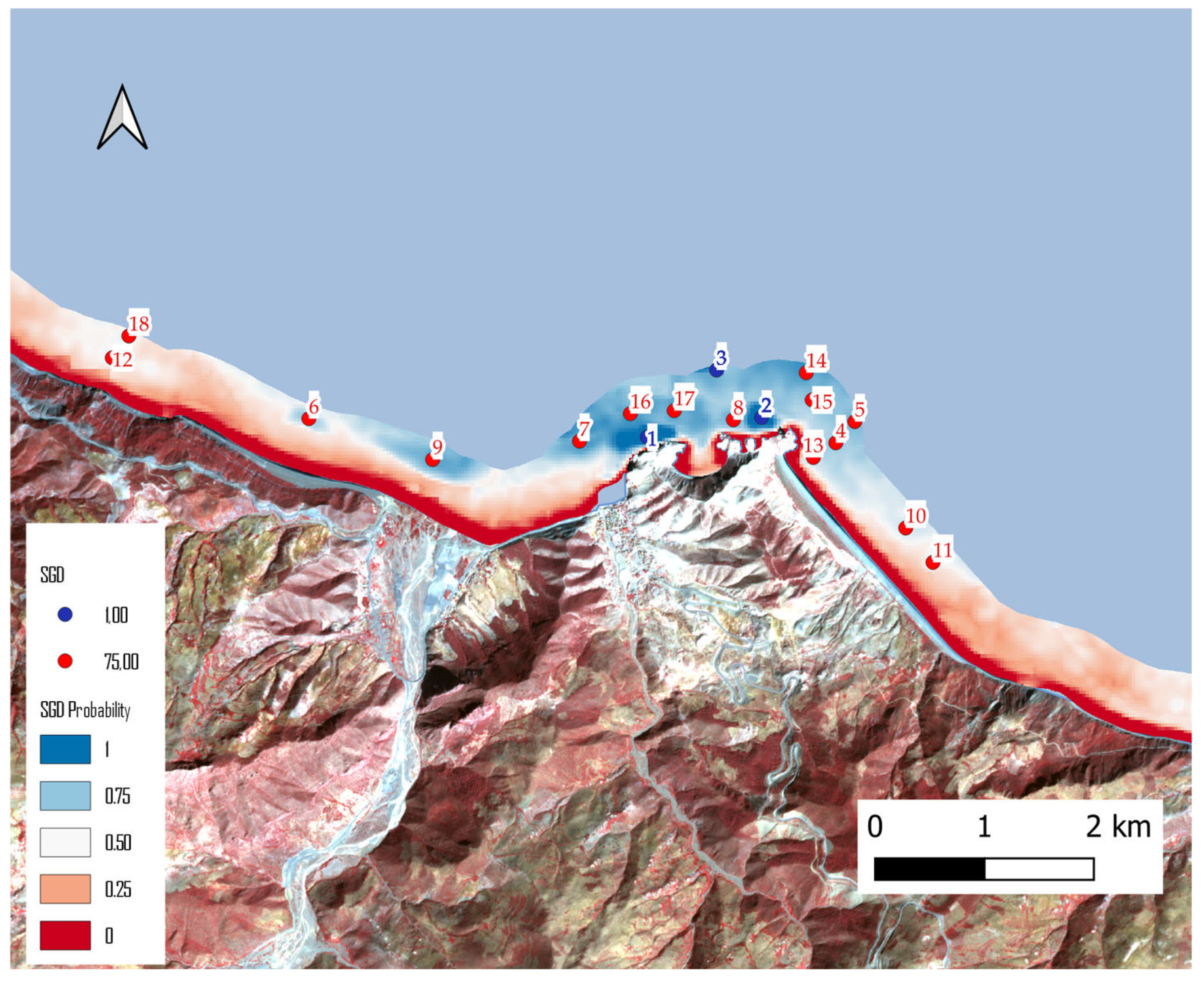
4. Discussion
- 3 SGD in the highest probability category
- 15 SGD in the lower probability category
5. Conclusions
Author Contributions
Funding
Data Availability Statement
Acknowledgments
Conflicts of Interest
Abbreviations
| SGD | Submarine groundwater discharge |
| ASM | Automatic seepage meter |
| CFC | Chlorofluorocarbons |
| SMOS | Soil Moisture and Ocean Salinity |
| Smap | Soil moisture active passive |
| RFI | Radio frequency interference |
| LSC | Land-sea contamination |
| LGBM | Light gradient boosting model |
| RMSE | Root-mean-square error |
| MODIS | Moderate-resolution imaging spectroradiometer |
| SEVIRI | Spinning enhanced visible infrared imager |
References
- Moore, W.S. The effect of submarine groundwater discharge on the ocean. Ann. Rev. Mar. Sci. 2010, 2, 59–88. [Google Scholar] [CrossRef] [PubMed]
- Moore, W.S.; Joye, S.B. Saltwater Intrusion and Submarine Groundwater Discharge: Acceleration of Biogeochemical Reactions in Changing Coastal Aquifers. Front. Earth Sci. 2021, 9, 600710. [Google Scholar] [CrossRef]
- Kim, K.H.; Heiss, J.W. Methods in Capturing the Spatiotemporal Dynamics of Flow and Biogeochemical Reactivity in Sandy Beach Aquifers: A Review. Water 2021, 13, 782. [Google Scholar] [CrossRef]
- Goyetche, T.; Luquot, L.; Carrera, J.; Martínez-Pérez, L.; Folch, A. Identification and quantification of chemical reactions in a coastal aquifer to assess submarine groundwater discharge composition. Sci. Total Environ. 2022, 838, 155978. [Google Scholar] [CrossRef]
- Burnett, W.C.; Dulaiova, H. Estimating the dynamics of groundwater input into the coastal zone via continuous radon-222 measurements. J. Environ. Radioact. 2003, 69, 21–35. [Google Scholar] [CrossRef]
- Taniguchi, M.; Dulai, H.; Burnett, K.M.; Santos, I.R.; Sugimoto, R.; Stieglitz, T.; Kim, G.; Moosdorf, N.; Burnett, W.C. Submarine Groundwater Discharge: Updates on Its Measurement Techniques, Geophysical Drivers, Magnitudes, and Effects. Front. Environ. Sci. 2019, 7, 141. [Google Scholar] [CrossRef]
- Alorda-Kleinglass, A.; Garcia-Orellana, J.; Rodellas, V.; Cerdà-Domènech, M.; Tovar-Sánchez, A.; Diego-Feliu, M.; Trezzi, G.; Sánchez-Quilez, D.; Sanchez-Vidal, A.; Canals, M. Remobilization of dissolved metals from a coastal mine tailing deposit driven by groundwater discharge and porewater exchange. Sci. Total Environ. 2019, 688, 1359–1372. [Google Scholar] [CrossRef]
- Burnett, W.C.; Aggarwal, P.K.; Aureli, A.; Bokuniewicz, H.; Cable, J.E.; Charette, M.A.; Kontar, E.; Krupa, S.; Kulkarni, K.M.; Loveless, A.; et al. Quantifying submarine groundwater discharge in the coastal zone via multiple methods. Sci. Total Environ. 2006, 367, 498–543. [Google Scholar] [CrossRef]
- Bernichi, Y.; Amharref, M.; Bernoussi, A.S.; Frison, P.-L. Contribution Of Supervised And Unsupervised Classification In Inundation Mapping: A Case Study. E3S Web Conf. 2024, 502, 04007. [Google Scholar] [CrossRef]
- Mayer, A.L.; Lopez, R.D. Use of remote sensing to support forest and wetlands policies in the USA. Remote Sens. 2011, 3, 1211–1233. [Google Scholar] [CrossRef]
- Gil, L.K.T.; Martínez, D.V.; Saba, M. The Widespread Use of Remote Sensing in Asbestos, Vegetation, Oil and Gas, and Geology Applications. Atmosphere 2023, 14, 172. [Google Scholar] [CrossRef]
- Shumilo, L.; Shelestov, A.; Yailymov, B.; Brazhnyi, A.; Bilokonska, Y. Remote Sensing Data Usage for Smart City Greening Strategy Planning. In Proceedings of the IEEE EUROCON, Lviv, Ukraine, 6–8 July 2021; pp. 92–97. [Google Scholar]
- Song, H.; Zhang, Y.; Zhang, B.; Lv, Y.; Zhang, L. Coastal Regions Sea Surface Salinity Retrieval of SMAP MISSION Based on Light Gradient Boosting Model. In Proceedings of the 2024 Progress in Electromagnetics Research Symposium (PIERS), Chengdu, China, 21–25 April 2024; pp. 1–3. [Google Scholar]
- Tamborski, J.J.; Rogers, A.D.; Bokuniewicz, H.J.; Cochran, J.K.; Young, C.R. Identification and quantification of diffuse fresh submarine groundwater discharge via airborne thermal infrared remote sensing. Remote Sens. Environ. 2015, 171, 202–217. [Google Scholar] [CrossRef]
- Akawwi, E.; Al-Zouabi, A.; Kakish, M.; Koehn, F.; Sauter, M. Using Thermal Infrared Imagery (TIR) for Illustrating the Submarine Groundwater Discharge into the Eastern Shoreline of the Dead Sea-Jordan. Am. J. Environ. Sci. 2008, 4, 693–700. [Google Scholar] [CrossRef]
- Benmakhlouf, M.; Galindo-Zaldívar, J.; Chalouan, A.; Sanz de Galdeano, C.; Ahmamou, M.; López-Garrido, A.C. Cinemática y paleoesfuerzos en la zona de falla transcurrente de Jebha-Chrafate (Rif septentrional, Marruecos). Kinemat. Paleostresses Jebha-Chrafate Transcurrent Fault 2005, 38, 71–74. [Google Scholar]
- Amraoui, A. Hydrogéologie de la Dorsale Calcaire du Rif (Maroc Septentrional). Ph.D. Thesis, Université Joseph-Fourier—Grenoble I, Saint Martin of Heres, France, 31 October 1988. [Google Scholar]
- Suter, G. Carte Géologique de la Chaîne Rifaine [Map]; Échelle 1:500 000; Notes et Mémoires du Service Géologique du Maroc, No. 245a; Ministère de l’Énergie et des Mines, Direction de la Géologie: Rabat, Morocco, 1980.
- Agence du Bassin Hydraulique du Loukkos. Projet du Plan Directeur d’Aménagement Intégré des Ressources en Eau des Bassins Hydrauliques du Loukkos, Tangérois et Côtiers Méditerranéens; Agence du Bassin Hydraulique du Loukkos: Tanger, Morocco, 2022; pp. 1–147.
- Savatier, M.; Morrissey, P.; Gill, L.; Rocha, C. Intercomparison of marine tracer and catchment-based submarine groundwater discharge estimates for a karst aquifer. J. Hydrol. 2023, 627, 130358. [Google Scholar] [CrossRef]
- Jou-Claus, S.; Folch, A.; Garcia-Orellana, J. Applicability of Landsat 8 thermal infrared sensor for identifying submarine groundwater discharge springs in the Mediterranean Sea basin. Hydrol. Earth Syst. Sci. 2021, 25, 4789–4805. [Google Scholar] [CrossRef]
- What are the Band Designations for the Landsat Satellites?|U.S. Geological Survey. Available online: https://www.usgs.gov/faqs/what-are-band-designations-landsat-satellites (accessed on 13 April 2025).
- What are the Acquisition Schedules for the Landsat Satellites?|U.S. Geological Survey. Available online: https://www.usgs.gov/faqs/what-are-acquisition-schedules-landsat-satellites (accessed on 13 April 2025).
- Ahmed, M.R.; Ghaderpour, E.; Gupta, A.; Dewan, A.; Hassan, Q.K. Opportunities and Challenges of Spaceborne Sensors in Delineating Land Surface Temperature Trends: A Review. IEEE Sens. J. 2023, 23, 6460–6472. [Google Scholar] [CrossRef]
- Vinogradova, N.T.; Lee, T.; Boutin, J.; Drushka, K.; Fournier, S.; Sabia, R.; Stammer, D.; Bayler, E.; Reul, N.; Gordon, A.L.; et al. Satellite Salinity Observing System: Recent Discoveries and the Way Forward. Front. Mar. Sci. 2019, 6, 243. [Google Scholar] [CrossRef]
- Dossa, A.N.; Alory, G.; da Silva, A.C.; Dahunsi, A.M.; Bertrand, A. Global Analysis of Coastal Gradients of Sea Surface Salinity. Remote Sens. 2021, 13, 2507. [Google Scholar] [CrossRef]
- Lagerloef, G.; Font, J. SMOS and Aquarius/SAC-D Missions: The Era of Spaceborne Salinity Measurements is About to Begin. In Oceanography from Space: Revisited; Springer: Dordrecht, The Netherlands, 2010; pp. 35–58. [Google Scholar]
- Rodriguez-Fernandez, N.; Anterrieu, E.; Cabot, F.; Boutin, J.; Picard, G.; Pellarin, T.; Merlin, O.; Vialard, J.; Vivier, F.; Costeraste, J.; et al. A New L-Band Passive Radiometer For Earth Observation: SMOS-High Resolution (SMOS-HR). In Proceedings of the International Geoscience and Remote Sensing Symposium (IGARSS), Waikoloa, HI, USA, 26 September–2 October 2020; pp. 5978–5981. [Google Scholar]
- Sayler, K. Landsat 8–9 Collection 2 Level 2 Science Product Guide; U.S. Geological Survey: Reston, VA, USA, 2024.
- EarthExplorer. Available online: https://earthexplorer.usgs.gov/ (accessed on 25 March 2025).
- Landsat Collection 2 Quality Assessment Bands|U.S. Geological Survey. Available online: https://www.usgs.gov/landsat-missions/landsat-collection-2-quality-assessment-bands (accessed on 26 March 2025).
- Samani, A.N.; Farzin, M.; Rahmati, O.; Feiznia, S.; Kazemi, G.A.; Foody, G.; Melesse, A.M. Scrutinizing Relationships Between Submarine Groundwater Discharge and Upstream Areas Using Thermal Remote Sensing: A Case Study in the Northern Persian Gulf. Remote Sens. 2021, 13, 358. [Google Scholar] [CrossRef]
- Londoño-Londoño, J.E.; Condesso de Melo, M.T.; Nascimento, J.N.; Silva, A.C.F. Thermal−Based Remote Sensing Solution for Identifying Coastal Zones with Potential Groundwater Discharge. J. Mar. Sci. Eng. 2022, 10, 414. [Google Scholar] [CrossRef]
- Migiros, G. Groundwater Coastal Discharge of the Karstic System of the Mani Peninsula, Southern Peloponnesus-Greece. In Proceedings of the 8th International Hydrogeological Congress of Greece, Thessaloniki, Greece, 8–10 October 2008. [Google Scholar]
- Çakıt, E.; Karwowski, W. A fuzzy overlay model for mapping adverse event risk in an active war theatre. J. Exp. Theor. Artif. Intell. 2018, 30, 691–701. [Google Scholar] [CrossRef]
- Planet Team Planet Application Program Interface: In Space for Life on Earth. 2022. Available online: https://support.planet.com/hc/en-us/articles/115006038627-Citing-Planet-Data (accessed on 25 March 2025).
- Zlotnik, V.A.; Solomon, D.K.; Genereux, D.P.; Gilmore, T.E.; Humphrey, C.E.; Mittelstet, A.R.; Zlotnik, A.V. Theory of an Automatic Seepage Meter and Ramifications for Applications. Water Resour. Res. 2023, 59, e2023WR034766. [Google Scholar] [CrossRef]
- Schlüter, M.; Maier, P. Submarine Groundwater Discharge from Sediments and Sand Boils Quantified by the Mean Residence Time of a Tracer Injection. Front. Earth Sci. 2021, 9, 710000. [Google Scholar] [CrossRef]
- Lino, Y.; Udayashankar, H.N.; Suresh Babu, D.S.; Ramasamy, M.; Balakrishna, K. Large submarine groundwater discharges to the Arabian Sea from tropical southwestern Indian Coast: Measurements from seepage meters deployed during the low tide. J. Hydrol. 2023, 620, 129394. [Google Scholar] [CrossRef]
- Rosenberry, D.O.; Duque, C.; Lee, D.R. History and evolution of seepage meters for quantifying flow between groundwater and surface water: Part 1—Freshwater settings. Earth-Sci. Rev. 2020, 204, 103167. [Google Scholar] [CrossRef]
- Lee, C.; Kim, W.; Jeen, S.-W. Measurement of Flux at Sediment–Water Interface Using a Seepage Meter Under Controlled Flow Conditions. Water 2020, 12, 3071. [Google Scholar] [CrossRef]
- Islami, N.; Irianti, M. A Quantitative interpretation of salt water mixture in the shallow aquifer through the geoelectrical resistivity data. J. Phys. Conf. Ser. 2023, 2582, 012001. [Google Scholar] [CrossRef]
- Tur-Piedra, J.; Ledo, J.; Queralt, P.; Marcuello, A.; Diego-Feliu, M.; Alorda-Kleinglass, A.; Rodellas, V.; Folch, A. Combining terrestrial and marine electrical resistivity methods to improve data acquisition in the land-sea transition zone. In Proceedings of the 25th EGU General Assembly, Vienna, Austria, 23–28 April 2023. [Google Scholar] [CrossRef]
- Syamsuddin, S.; Fajar, M.; Wirawan, A.H.; Salsabila, N.; Rezky, R.; Massinai, M.F.I.; Selfiana, S.; Harimei, B. Determination of Seawater Intrusion Zones Using the Resistivity Method in Kelurahan Soreang, Maros District, South Sulawesi Province: Penentuan Zona Intrusi Air Laut Menggunakan Metode Tahanan Jenis di Kelurahan Soreang, Kabupaten Maros. Geocelebes 2023, 7, 99–107. [Google Scholar] [CrossRef]
- Unnikrishnan, P.K.N.; Balan, S.; Srinivas, R.; Suresh Babu, D.S. Evaluation of submarine groundwater discharge and associated beach groundwater dynamics. ISH J. Hydraul. Eng. 2023, 29, 121–131. [Google Scholar] [CrossRef]
- Porru, M.C.; Arras, C.; Biddau, R.; Cidu, R.; Lobina, F.; Podda, F.; Wanty, R.; Da Pelo, S. Assessing Recharge Sources and Seawater Intrusion in Coastal Groundwater: A Hydrogeological and Multi-Isotopic Approach. Water 2024, 16, 1106. [Google Scholar] [CrossRef]
- Geranmehr, M.; Bau, D.; Mayer, A.; Mancewicz, L.; Yu, W. Seawater Intrusion Mechanisms in Heterogeneous Coastal Aquifers Subject to Pumping. In Proceedings of the European Geosciences Union General Assembly (EGU24) 2024, Vienna, Austria, 14–19 April 2024. [Google Scholar] [CrossRef]
- Morton, K. The use of groundwater monitoring and underground pressure release tests to benefit block caving. In Proceedings of the Caving 2022: Fifth International Conference on Block and Sublevel Caving, Perth, Australia, 30 August–1 September 2022; pp. 611–622. [Google Scholar]
- Romano, G.; Capozzoli, L.; Lapenna, V.; Polemio, M. A new multiscale and multisensory strategy for the characterization of groundwater discharge in coastal areas The SUBGEO project. In Proceedings of the EGU General Assembly 2024, Vienna, Austria, 14–19 April 2024. [Google Scholar] [CrossRef]
- Da Pelo, S.; Porru, M.C.; Piscedda, F.A.; Testa, M.; Lorrai, M.; Botti, P.; Lobina, F.; Arras, C.; Buttau, C.; Loi, A.; et al. Monitoring of physical-chemical parameter depth profile to assess sea water intrusion phenomena in a coastal multi-layer aquifer. In Proceedings of the 24th EGU General Assembly, Vienna, Austria, 23–27 May 2022. [Google Scholar] [CrossRef]
- Pezard, P.; Henry, G.; Brun, L.; Gee, R.; Folch, A.; Goyetche, T.; Martinez, L.; Carrera, J.; Luquot, L. Innovative downhole geophysical methods, petrophysical characterization and high frequency downhole monitoring of seawater intrusion dynamics in a coastal aquifer. The Me Distraes project, Argentona, Spain. In Proceedings of the IAHS-AISH Scientific Assembly 2022, Montpellier, France, 29 May–3 June 2022. [Google Scholar] [CrossRef]
- Jiménez-Valera, J.A.; Alhama, I.; Trigueros, E. Quantification of Groundwater Vertical Flow from Temperature Profiles: Application to Agua Amarga Coastal Aquifer (SE Spain) Submitted to Artificial Recharge. Water 2023, 15, 1093. [Google Scholar] [CrossRef]
- Post, V.E.A.; Banks, E.; Brunke, M. Groundwater flow in the transition zone between freshwater and saltwater: A field-based study and analysis of measurement errors. Hydrogeol. J. 2018, 26, 1821–1838. [Google Scholar] [CrossRef]
- Schubert, M.; Lin, M.; Clark, J.F.; Kralik, M.; Damatto, S.; Copia, L.; Terzer-Wassmuth, S.; Harjung, A. Short-lived natural radionuclides as tracers in hydrogeological studies—A review. Sci. Total Environ. 2024, 920, 170800. [Google Scholar] [CrossRef]
- Moore, W.S.; Benitez-Nelson, C.; Schutte, C.; Moody, A.; Shiller, A.; Sibert, R.J.; Joye, S. SGD-OD: Investigating the potential oxygen demand of submarine groundwater discharge in coastal systems. Sci. Rep. 2024, 14, 9249. [Google Scholar] [CrossRef]
- Somot, S.; Houpert, L.; Sevault, F.; Testor, P.; Bosse, A.; Taupier-Letage, I.; Bouin, M.-N.; Waldman, R.; Cassou, C.; Sanchez-Gomez, E.; et al. Characterizing, modelling and understanding the climate variability of the deep water formation in the North-Western Mediterranean Sea. Clim. Dyn. 2018, 51, 1179–1210. [Google Scholar] [CrossRef]
- Cusinato, E.; Zanchettin, D.; Sannino, G.; Rubino, A. Mediterranean Thermohaline Response to Large-Scale Winter Atmospheric Forcing in a High-Resolution Ocean Model Simulation. Pure Appl. Geophys. 2018, 175, 4083–4110. [Google Scholar] [CrossRef]
- Milanolo, S. Sources and Transport of Inorganic Carbon in the Unsaturated Zone of Karst; Springer: Berlin/Heidelberg, Germany, 2016. [Google Scholar]
- Nhu, V.-H.; Rahmati, O.; Falah, F.; Shojaei, S.; Al-Ansari, N.; Shahabi, H.; Shirzadi, A.; Górski, K.; Nguyen, H.; Ahmad, B.B. Mapping of Groundwater Spring Potential in Karst Aquifer System Using Novel Ensemble Bivariate and Multivariate Models. Water 2020, 12, 985. [Google Scholar] [CrossRef]

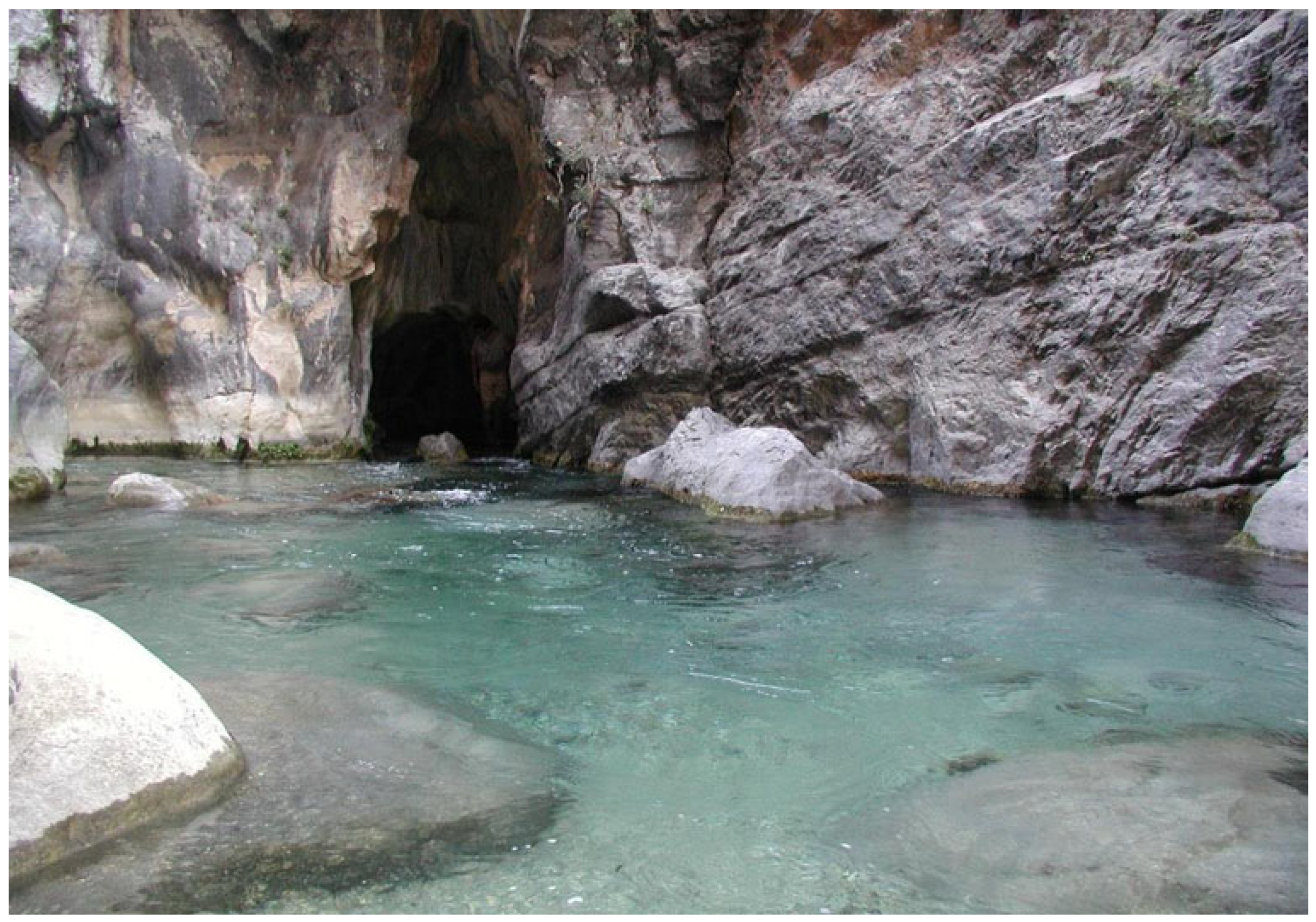
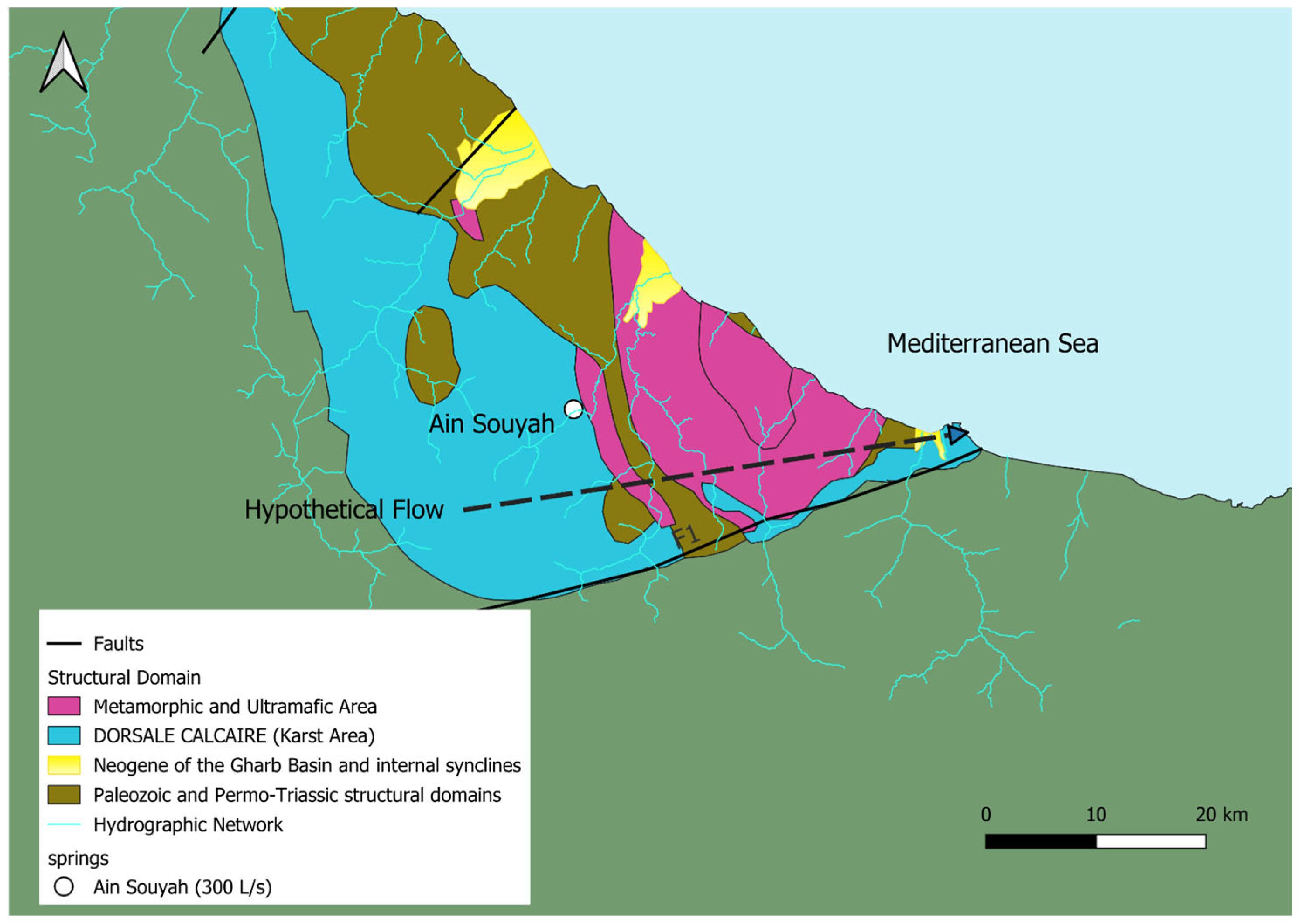

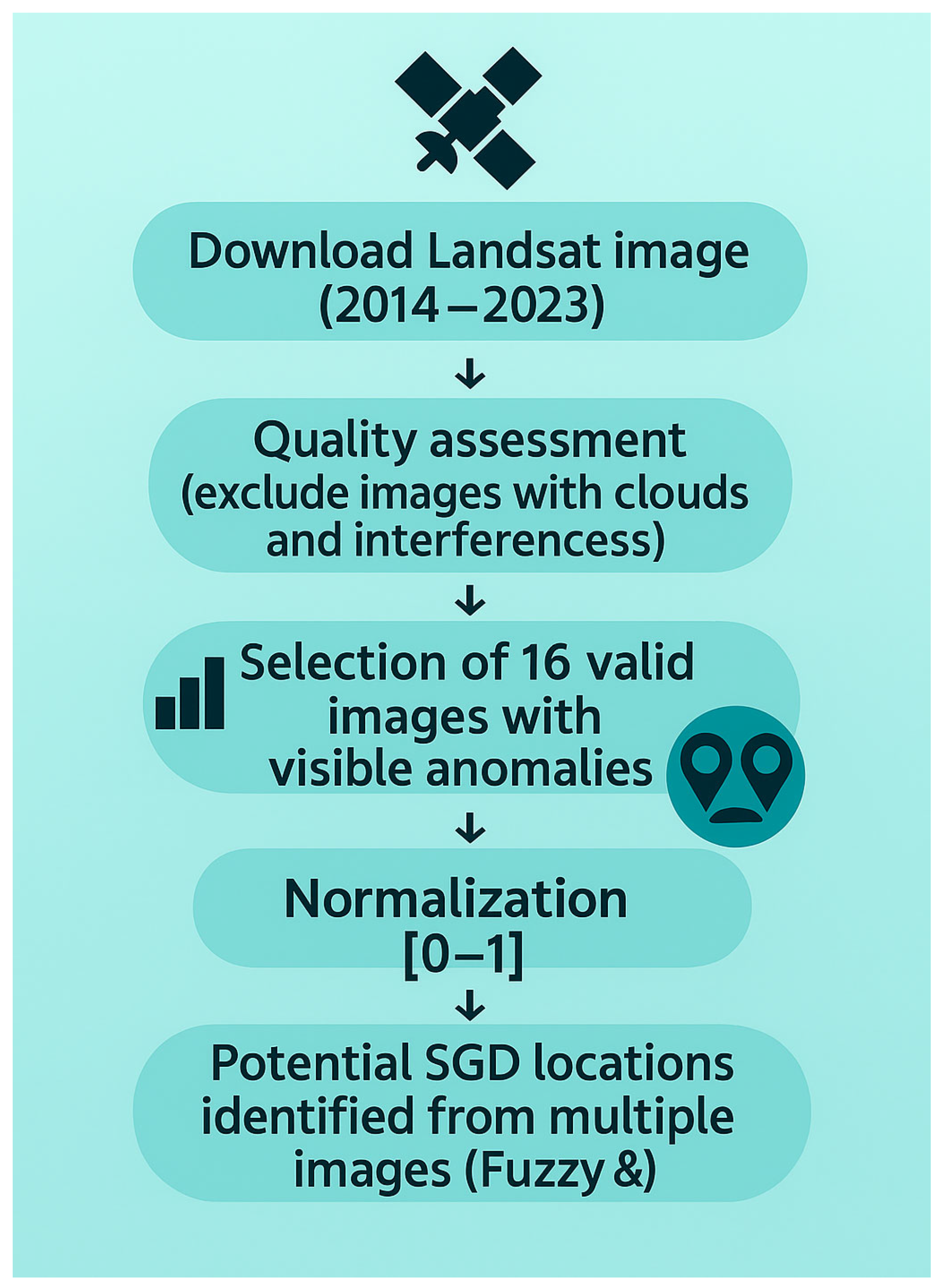
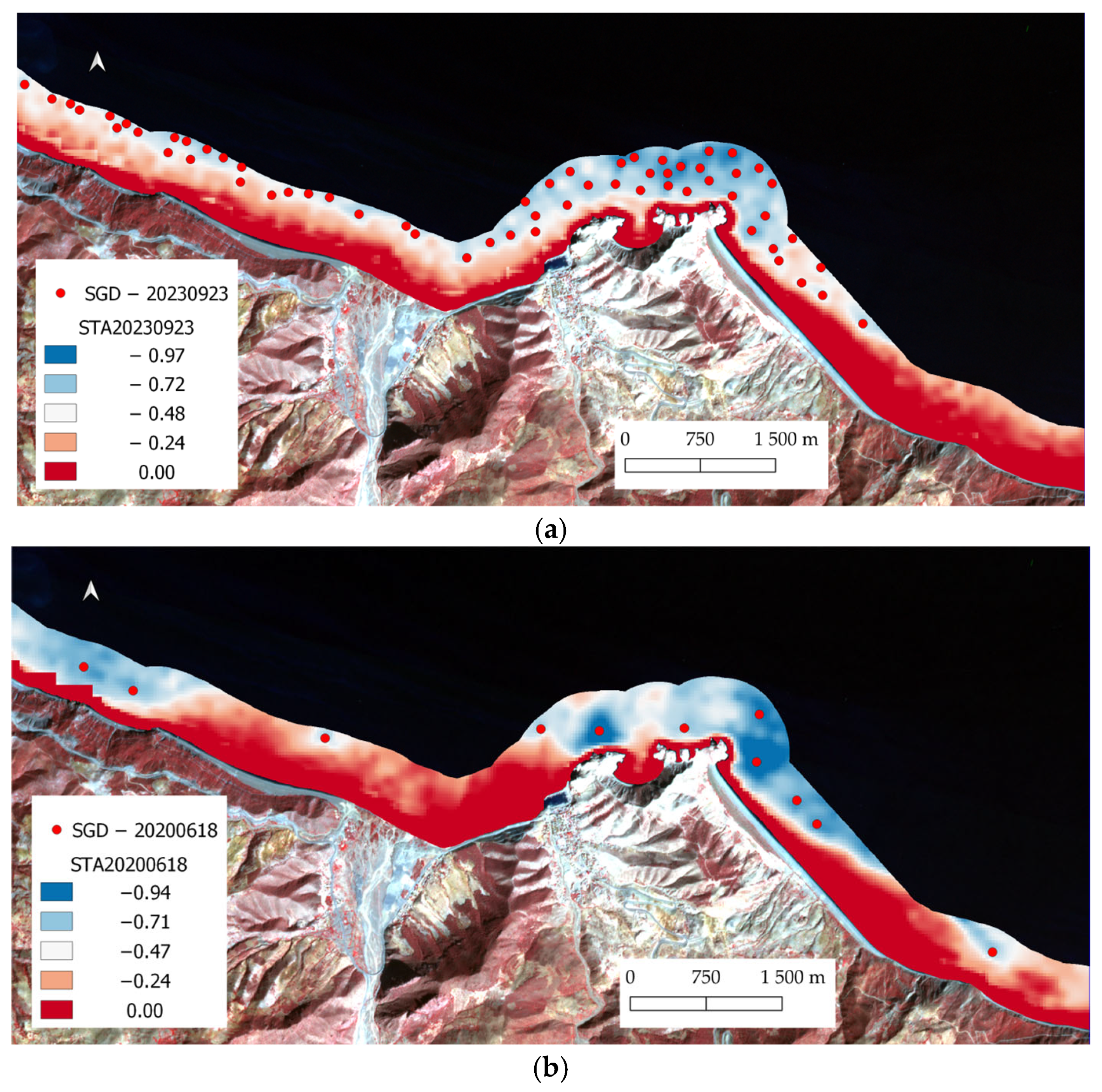
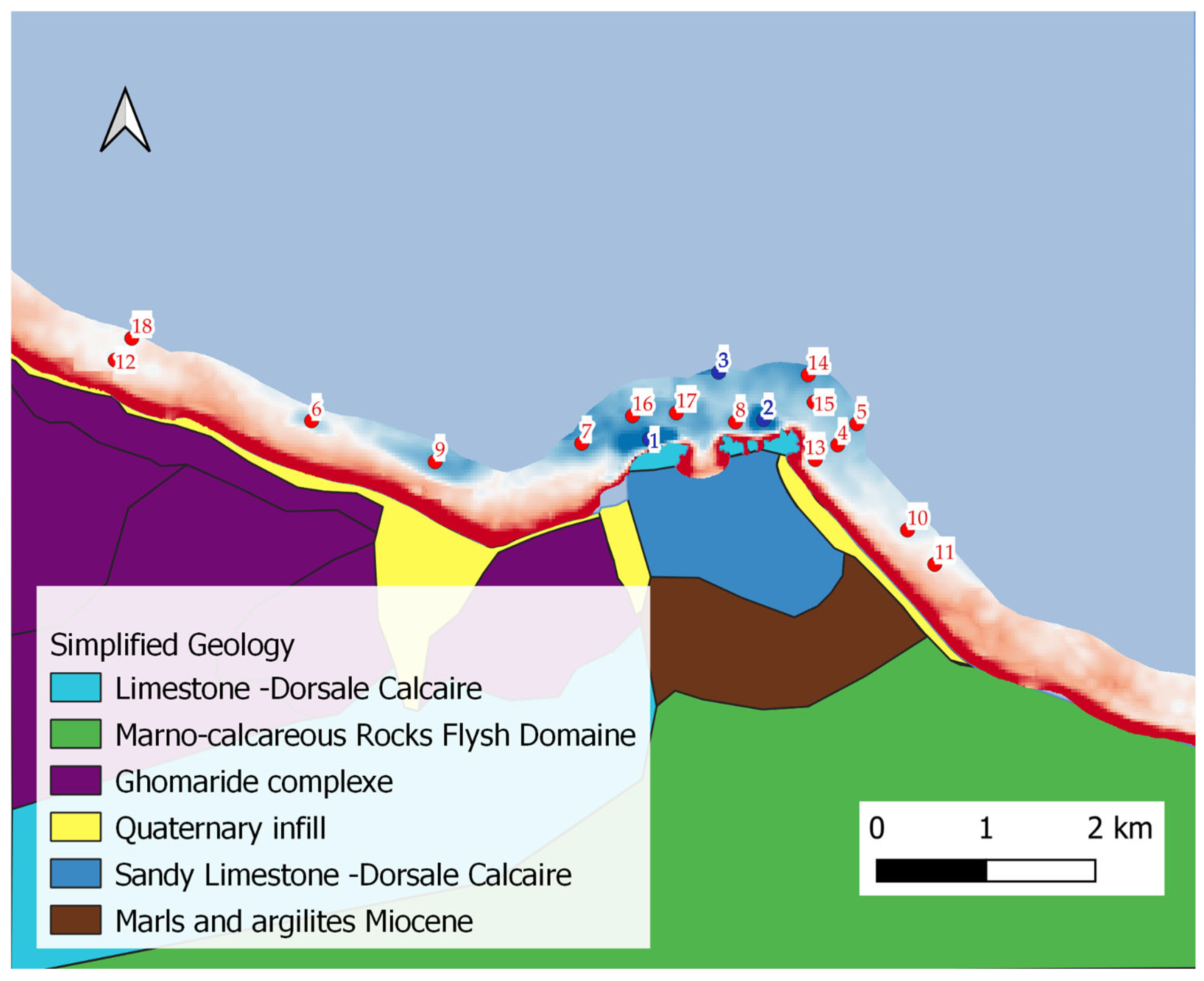
| Scene ID | Date | Scene Center Time (UTC) | Path | Row | Number of Anomalies | Season |
|---|---|---|---|---|---|---|
| LC08_L2SP_201035_20140602 | 2 June 2014 | 10:56:23Z | 201 | 35 | 27 | Summer |
| LC08_L2SP_201035_20141024 | 24 October 2014 | 10:56:59Z | 201 | 35 | 28 | Autumn |
| LC08_L2SP_201035_20150707 | 7 July 2015 | 10:56:14Z | 201 | 35 | 31 | Summer |
| LC08_L2SP_201035_20170914 | 14 September 2017 | 10:56:52Z | 201 | 35 | 15 | Autumn |
| LC08_L2SP_201036_20180613 | 13 June 2018 | 10:56:02Z | 201 | 36 | 30 | Summer |
| LC08_L2SP_201035_20190702 | 2 July 2019 | 10:56:40Z | 201 | 35 | 25 | Summer |
| LC08_L2SP_201035_20190718 | 18 July 2019 | 10:56:43Z | 201 | 35 | 40 | Summer |
| LC08_L2SP_201035_20190803 | 3 August 2019 | 10:56:50Z | 201 | 35 | 31 | Summer |
| LC08_L2SP_201035_20191006 | 6 October 2019 | 10:57:08Z | 201 | 35 | 50 | Autumn |
| LC08_L2SP_201035_20200922 | 22 September 2020 | 10:57:03Z | 201 | 35 | 13 | Autumn |
| LC08_L2SP_201035_20200618 | 18 June 2020 | 10:56:27Z | 201 | 35 | 11 | Summer |
| LC09_L2SP_201035_20220718 | 18 July 2022 | 10:56:38Z | 201 | 35 | 15 | Summer |
| LC08_L2SP_201035_20220726 | 26 July 2022 | 10:57:08Z | 201 | 35 | 14 | Summer |
| LC08_L2SP_201035_20230611 | 11 June 2023 | 10:56:12Z | 201 | 35 | 37 | Summer |
| LC08_L2SP_201035_20230729 | 29 July 2023 | 10:56:35Z | 201 | 35 | 35 | Summer |
| LC09_L2SP_201035_20230923 | 23 September 2023 | 10:56:49Z | 201 | 35 | 61 | Autumn |
Disclaimer/Publisher’s Note: The statements, opinions and data contained in all publications are solely those of the individual author(s) and contributor(s) and not of MDPI and/or the editor(s). MDPI and/or the editor(s) disclaim responsibility for any injury to people or property resulting from any ideas, methods, instructions or products referred to in the content. |
© 2025 by the authors. Licensee MDPI, Basel, Switzerland. This article is an open access article distributed under the terms and conditions of the Creative Commons Attribution (CC BY) license (https://creativecommons.org/licenses/by/4.0/).
Share and Cite
Bernichi, Y.; Amharref, M.; Bernoussi, A.-S.; Frison, P.-L. Using Landsat 8/9 Thermal Bands to Detect Potential Submarine Groundwater Discharge (SGD) Sites in the Mediterranean in North West-Central Morocco. Hydrology 2025, 12, 144. https://doi.org/10.3390/hydrology12060144
Bernichi Y, Amharref M, Bernoussi A-S, Frison P-L. Using Landsat 8/9 Thermal Bands to Detect Potential Submarine Groundwater Discharge (SGD) Sites in the Mediterranean in North West-Central Morocco. Hydrology. 2025; 12(6):144. https://doi.org/10.3390/hydrology12060144
Chicago/Turabian StyleBernichi, Youssef, Mina Amharref, Abdes-Samed Bernoussi, and Pierre-Louis Frison. 2025. "Using Landsat 8/9 Thermal Bands to Detect Potential Submarine Groundwater Discharge (SGD) Sites in the Mediterranean in North West-Central Morocco" Hydrology 12, no. 6: 144. https://doi.org/10.3390/hydrology12060144
APA StyleBernichi, Y., Amharref, M., Bernoussi, A.-S., & Frison, P.-L. (2025). Using Landsat 8/9 Thermal Bands to Detect Potential Submarine Groundwater Discharge (SGD) Sites in the Mediterranean in North West-Central Morocco. Hydrology, 12(6), 144. https://doi.org/10.3390/hydrology12060144







